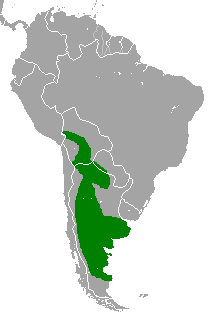Drylands vesper mouse facts for kids
Quick facts for kids Drylands vesper mouse |
|
|---|---|
| Conservation status | |
| Scientific classification | |
| Genus: |
Calomys
|
| Species: |
musculinus
|
 |
|
| Calomys musculinus range map | |
The drylands vesper mouse (scientific name: Calomys musculinus) is a small rodent that belongs to the family Cricetidae. These tiny mice are found in parts of South America. You can find them living in countries like Argentina, Bolivia, and Paraguay.
Contents
What is a Drylands Vesper Mouse?
The drylands vesper mouse is a type of mouse that lives in dry areas. It's a small mammal, often active at night. Like other rodents, it has strong front teeth for gnawing. These mice are an important part of their ecosystem. They help control insect populations and also serve as food for other animals.
Where Do They Live?
Drylands vesper mice prefer dry, open spaces. They live in grasslands, shrublands, and sometimes even agricultural fields. These areas are often found in the central and northern parts of Argentina, Bolivia, and Paraguay. They build their homes, called burrows, underground. These burrows keep them safe from predators and bad weather.
What Do They Eat?
These mice are mostly herbivores, meaning they eat plants. Their diet mainly includes seeds, grains, and different parts of plants. Sometimes, they might also eat insects. They are important for spreading seeds around their habitat. This helps new plants grow.
How Big Are They?
The drylands vesper mouse is quite small. An adult mouse usually measures about 8 to 12 centimeters (around 3 to 5 inches) long. This measurement does not include their tail. Their tail can be almost as long as their body. They have soft fur, which is usually brownish-gray on their back and lighter on their belly.
Are They in Danger?
The drylands vesper mouse is currently listed as "Least Concern" by the IUCN. This means they are not considered to be in danger of extinction right now. They are quite common in their natural habitats. However, like all animals, their populations can be affected by changes to their environment. Things like habitat loss or changes in farming practices can impact them.
See also
 In Spanish: Ratón maicero para niños
In Spanish: Ratón maicero para niños


